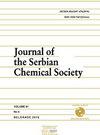苯脲类除草剂化学键性质、芳香性指标及分子对接的DFT研究
IF 1
4区 化学
Q4 CHEMISTRY, MULTIDISCIPLINARY
引用次数: 0
摘要
除草剂对环境和人类健康造成了灾难性的后果。这种做法促使科学家调查这些物质的物理、化学和生物特性,从而避免使用最有害的杀虫剂。为此,利用密度泛函理论(DFT)计算了苯脲类除草剂Fenuron (L1)、Monuron (L2)、Diuron (L3)和Chlorotoluron (L4)在水中的分子结构和化学键性质。能量分解分析(EDA)和化学价态扩展过渡态自然轨道(ETS-NOCV)揭示了二甲基脲片段与苯环之间碳氮键的主要离子特征。此外,通过分子模型研究了这些除草剂与人血清白蛋白(HSA)的相互作用。HOMA和FLU指数的计算表明,Diuron的电子离域比其他化合物更强,这主要是由于两个氯取代基对苯的影响。计算得到的结构参数、Mulliken原子电荷、拓扑和键合性能以及芳香性指标之间存在良好的相关性。Vinardo分子对接结果表明,HSA靶物与所研究化合物之间形成的配合物的结合能顺序为:L3 (-27.57 kJ/mol) <L2 (-25.56 kJ/mol) <L4 (-24.94 kJ/mol) <L1 (-24.10 kJ/mol),证实了吡脲是所研究除草剂中危害较小的选择,特别是对HSA。本文章由计算机程序翻译,如有差异,请以英文原文为准。
A DFT study of the chemical bonding properties, aromaticity indexes and molecular docking study of some phenylureas herbicides
Herbicides have implied disastrous consequences towards the environment and human health. This practice urges scientists to investigate the physical, chemical and biological properties of these substances, hence avoiding the use of the most harmful pesticides. For this purpose, the molecular structure and chemical bonding properties of phenylurea herbicides namely: Fenuron (L1), Monuron (L2), Diuron (L3) and Chlorotoluron (L4), were calculated in water using density functional theory (DFT). The energy decomposition analysis (EDA) and the extended transition state natural orbitals for chemical Valence (ETS-NOCV) reveal the dominant ionic character in Carbon-Nitrogen bond between dimethylurea fragment and benzene ring. Besides, the interaction of these herbicides with the Human Serum Albumin (HSA) was undertaken by molecular modeling. The calculation of HOMA and FLU indexes indicate that the electronic delocalization is stronger in Diuron than the other compounds, mainly caused by the two chloro substituents effects on benzene. Good correlations are found between the calculated parameters such as structural parameters, Mulliken atomic charge, topological and bonding properties and aromaticity indexes. The Vinardo molecular docking results suggest that, the binding energies of the complexes formed between HSA target and investigated compounds have the following order: L3 (-27.57 kJ/mol) < L2 (-25.56 kJ/mol) < L4 (-24.94 kJ/mol) < L1 (-24.10 kJ/mol), which confirmed that the Fenuron is the less harmful option between the studied herbicides especially against HSA.
求助全文
通过发布文献求助,成功后即可免费获取论文全文。
去求助
来源期刊
CiteScore
1.80
自引率
0.00%
发文量
76
审稿时长
1 months
期刊介绍:
The Journal of the Serbian Chemical Society -JSCS (formerly Glasnik Hemijskog društva Beograd) publishes articles original papers that have not been published previously, from the fields of fundamental and applied chemistry:
Theoretical Chemistry, Organic Chemistry, Biochemistry and Biotechnology, Food Chemistry, Technology and Engineering, Inorganic Chemistry, Polymers, Analytical Chemistry, Physical Chemistry, Spectroscopy, Electrochemistry, Thermodynamics, Chemical Engineering, Textile Engineering, Materials, Ceramics, Metallurgy, Geochemistry, Environmental Chemistry, History of and Education in Chemistry.

 求助内容:
求助内容: 应助结果提醒方式:
应助结果提醒方式:


